Why this resume works
- Quantifies accomplishments: By incorporating measurable accomplishments, such as improving efficiency by 30% and reducing errors by 15%, the applicant emphasizes their tangible impact and value.
- Uses action-oriented language: Strong action verbs like “managed,” “coordinated,” and “streamlined” convey a results-driven mindset, showcasing initiative and an active approach.
- Illustrates problem-solving ability: Solving delays with a 25% reduction showcases how process improvements addressed inefficiencies, reflecting problem-solving skills, adaptability, and innovation.
More Project Coordinator Resume Examples
Check out our project coordinator resume examples to learn how to showcase your organizational skills, teamwork experience, and leadership abilities. These administrative resume samples will help you craft a resume for various coordination roles.
Entry-Level Project Coordinator
Why this resume works
- Effective use of keywords: Integrating role-specific keywords like “agile methodologies” and “resource allocation,” the applicant improves their chances of passing applicant tracking systems (ATS) and standing out to employers.
- Centers on academic background: By spotlighting advanced degrees in management, the applicant’s education section emphasizes academic achievements.
- Puts skills at the forefront: The skills-based resume format effectively showcases expertise like project management and risk assessment upfront.
Mid-Level Project Coordinator
Why this resume works
- Includes a mix of soft and hard skills: Combining interpersonal skills with technical acumen, the applicant balances team coordination and project planning to drive efficiency in high-budget environments.
- Demonstrates language abilities: The resume’s emphasis on multilingual abilities, including Spanish and French, showcases strong language skills essential for cross-cultural collaboration.
- Displays technical expertise: With certifications like Certified Project Management Professional, the applicant displays robust technical expertise important for managing complex projects efficiently.
Experienced Project Coordinator
Why this resume works
- Lists relevant certifications: By listing certifications such as the Certified Project Management Professional and Agile Certification, the applicant showcases expertise and a commitment to continuous learning, reinforcing their qualifications.
- Showcases impressive accomplishments: The applicant’s accomplishments, including a $500K cost-saving strategy and an award-winning project module, reflect senior-level impact and business success.
- Sections are well-organized: The resume’s clear use of bullet points and headers ensures easy scanning, organizing complex details into digestible sections that improve readability for potential employers.
Project Coordinator Resume Template (Text Version)
Min Huang
Greenfield, IN 46144
(555)555-5555
Min.Huang@example.com
Professional Summary
Experienced Project Coordinator with 8 years of industry expertise in managing budgets, leading teams, and enhancing project efficiency. Proven track record in delivering successful projects using agile methodologies.
Work History
Project Coordinator
Strategic Solutions Inc. – Greenfield, IN
January 2022 – June 2025
- Managed 0K project budget and timelines.
- Coordinated cross-functional teams of 15 members.
- Improved project efficiency by 30% using agile methodologies.
Project Manager
Bright Future Group – Indianapolis, IN
September 2018 – December 2021
- Led 0K project implementation.
- Oversaw team of 10 members with 15% error reduction.
- Enhanced client satisfaction by 20% through efficient project delivery.
Assistant Project Manager
Innovative Solutions Ltd. – Indianapolis, IN
June 2017 – August 2018
- Assisted in 0K project planning.
- Coordinated team efforts reducing delays by 25%.
- Streamlined processes improving productivity by 10%.
Languages
- Spanish – Beginner (A1)
- French – Intermediate (B1)
- German – Beginner (A1)
Skills
- Project Management
- Team Leadership
- Budgeting
- Risk Management
- Agile Methodologies
- Process Improvement
- Stakeholder Communication
- Time Management
Certifications
- Project Management Professional (PMP) – PMI
- Certified ScrumMaster (CSM) – Scrum Alliance
- Lean Six Sigma Green Belt – IASSC
Education
Master’s in Project Management Project Management
University of Texas Austin, TX
May 2017
Bachelor’s in Business Administration Business Administration
University of California Berkeley, CA
May 2015
Related Resume Guides
- Bank Clerk
- Bilingual Receptionist
- City Clerk
- Contract Administrator
- Data Entry Clerk
- Desktop Support Engineer
- Document Controller
- Document Specialist
- Executive Assistant
- Facilities Coordinator
- Facilities Manager
- Front Desk Clerk
- Front Office Assistant
- Front Office Executive
- Gym Receptionist
- Medical Billing
- Medical Billing And Coding
- Medical Office Assistant
- Medical Receptionist
- Office Administrator
- Office Assistant
- Office Manager
- Personal Assistant
- Procurement Analyst
- Procurement Officer
- Receptionist
- Secretary
- Store Assistant
- Unit Clerk
Advice for Writing Your Project Coordinator Resume
Explore tailored advice on how to write a resume for a project coordinator role, and discover how to highlight your knack for organization, communication skills, and ability to keep projects on track.
Highlight your most relevant skills
Listing relevant skills when applying for a job is important because it shows you are a good fit for the position. For a project coordinator role, highlighting your skills helps employers quickly see that you have the abilities needed to manage projects effectively. Creating a dedicated skills section on your resume makes it easy for hiring managers to find and understand what you bring to the table.
In this section, balance technical skills like project management software skills and budgeting with interpersonal skills such as communication and teamwork. This mix demonstrates that you can handle both the tasks required and work well with others. Make sure each skill listed is directly related to the project coordinator role to keep it focused.
To make an even stronger impact, integrate key skills into your work experience section. For example, mention how your organizational skills helped complete projects on time or how your problem-solving abilities resolved issues during a project’s lifecycle. Showing real-world examples of these skills in action gives more depth to your resume and proves you are capable of performing the job successfully.
Choose a resume format that highlights your skills in managing timelines, resources, and team coordination.
Showcase your accomplishments
When organizing your work experience for a project coordinator role, list your jobs in reverse chronological order, starting with the most recent. Each job entry should include your job title, employer name, location, and employment dates. This helps hiring managers quickly see your career progression and recent experience.
To make your resume stand out, turn job duties into achievements by quantifying them. Instead of just listing responsibilities, show measurable results like percentages, time savings, cost reductions, or efficiency improvements.
For example, instead of saying “managed project schedules,” you could say “reduced project completion time by 20% through efficient schedule management.” Using action-oriented words and focusing on core duties with measurable achievements demonstrates your impact and skills.
Quantified accomplishments help hiring managers quickly assess what you bring to the table. By showing concrete results from your past roles as a project coordinator, you prove that you can deliver similar successes in their organization. Use numbers wherever possible to highlight the specific impacts you’ve made in previous positions.
5 project coordinator work history bullet points
- Coordinated cross-functional teams in the successful delivery of 10+ projects, achieving a 95% on-time completion rate.
- Streamlined project documentation processes, reducing administrative overhead by 20% and improving team efficiency.
- Managed project budgets totaling over $1 million, consistently maintaining costs within 5% of initial estimates.
- Facilitated weekly stakeholder meetings to ensure alignment on project goals, resulting in a 30% increase in stakeholder satisfaction scores.
- Implemented a new project tracking system that decreased project update time by 40%, improving real-time visibility for senior management.
Choose a simple and neat resume template with easy-to-read fonts and clear section titles, avoiding flashy designs or colorful fonts to let your skills and work history stand out.
Write a strong professional summary
A professional summary is a quick introduction on a resume that helps hiring managers understand who you are. It’s like the first handshake in an interview, making that all-important first impression. When writing a resume, you can choose between a professional summary or an objective to start.
A professional summary is for those with experience. It’s three to four sentences that show your skills, experience, and achievements. It helps tell your professional story and shows how you add value as a project coordinator. A summary is ideal for applicants who have worked in their field for several years and want to highlight their accomplishments.
On the other hand, resume objectives are short statements of your career goals. They work well for entry-level applicants, those changing careers, or anyone with gaps in their work history. Think of it like this: summaries focus on “what I’ve accomplished,” while objectives say “what I aim to contribute.”
We’ll offer examples of both summaries and objectives tailored for different industries and levels of experience. Explore our library of resume examples for additional inspiration.
Project coordinator resume summary examples
Entry-level
Recent graduate with a Bachelor of Business Administration focusing on project management. Holds CAPM certification and possesses foundational skills in coordinating timelines, budgeting, and stakeholder communication through academic projects. Eager to support project teams in achieving their goals and contribute to efficient workflow processes.
Mid-career
Project coordinator with over five years of experience in managing cross-functional teams and driving project success within the technology sector. Known for implementing effective resource allocation strategies and improving project delivery times by 15%. Experienced in using agile methodologies and tools like Jira to streamline operations. A strong collaborator dedicated to improving team productivity.
Experienced
Seasoned project coordinator with over a decade of expertise in leading complex projects across various industries, including healthcare and finance. Proven track record in increasing operational efficiency by 20% through strategic planning and process optimization. Skilled in guiding teams through change management initiatives while fostering an environment of continuous improvement. Committed to driving impactful results that align with organizational objectives.
Project coordinator resume objective examples
Entry-level
Detail-oriented project coordinator with a background in business administration eager to apply organizational skills and knowledge of project management methodologies in a collaborative environment. Committed to supporting teams in executing projects efficiently and achieving milestones.
Career changer
Adaptable professional transitioning from customer service into project coordination, bringing strong communication abilities and problem-solving skills. Looking forward to contributing to cross-functional teams by facilitating effective project execution and improving team collaboration.
Recent graduate
Energetic recent graduate with a degree in communications seeking an entry-level role as a project coordinator, aiming to leverage research abilities and multitasking strengths to support dynamic projects. Dedicated to fostering seamless workflow processes and contributing positively to team objectives.
Make your resume shine! Use our Resume Builder to easily highlight your project coordinator skills and stand out to employers.
Match your resume to the job description
Tailoring resumes to job descriptions is essential because it helps job seekers stand out and pass through applicant tracking systems (ATS). ATS scans resumes for specific keywords and phrases from job postings. If your resume matches these terms, it’s more likely to get noticed by employers. This increases your chances of landing an interview.
An ATS-friendly resume includes specific keywords and phrases that align with the job description. By incorporating these terms, you can ensure your resume gets noticed by hiring managers. It’s important to use language that matches your skills and experiences to what the employer is looking for.
To identify keywords from job postings, focus on the skills, qualifications, and responsibilities that appear multiple times. Look for terms like “project scheduling,” “cross-functional collaboration,” or “budget tracking.” These are the key phrases applicant tracking systems (ATS) use to determine if your resume matches the job.
Incorporate these keywords naturally into your resume. For example, instead of saying “Managed project tasks,” you might say “Coordinated cross-functional project tasks to ensure on-time and on-budget delivery.” This approach helps align your experience with what employers are actively seeking.
Targeted resumes improve ATS compatibility by matching specific job requirements. When you customize your resume, this tailored approach helps ensure that your resume passes through ATS filters and reaches hiring managers, increasing your chances of getting hired as a project coordinator.
Want your resume to pass applicant tracking systems? Our ATS Resume Checker finds common mistakes and gives advice on how to make your resume better.
FAQ
Do I need to include a cover letter with my project coordinator resume?
Yes, including a cover letter with your project coordinator resume can be beneficial and help you stand out from other applicants. It provides an opportunity to highlight your organizational skills and experience in managing multiple tasks, which are important for the role of a project coordinator.
You can illustrate how you’ve successfully coordinated projects in the past, ensuring timelines were met and resources were allocated efficiently. If the company you’re applying to has specific projects or values that align with your experience or interests, mention them in your cover letter to show genuine enthusiasm.
Explore cover letter examples to find inspiration tailored to different job roles. Consider using tools like our Cover Letter Generator for guidance on crafting a personalized letter that complements your resume effectively.
How long should a project coordinator’s resume be?
For a project coordinator, one-page resume is typically best, focusing on key skills like organization, communication, and multitasking. Highlight your experience in coordinating projects, dealing with stakeholders, and using project management tools effectively.
If you have extensive experience or specialized certifications relevant to the role, a two-page resume can be justified. Make sure every detail included is meaningful and highlights your contributions to successful projects.
Explore our guide on how long a resume should be for examples and tips on determining the ideal length for your career stage.
How do you write a project coordinator resume with no experience?
When you lack direct experience, your project coordinator resume should highlight transferable skills, education, and any relevant projects or volunteer work that demonstrate your potential as a successful coordinator. Here are a few tips:
- Highlight education and certifications: Start with your degree in fields like business administration or management. If you’ve completed courses or certifications related to project management, such as a CAPM, include those as well.
- Leverage academic projects: Use school projects where you’ve managed timelines, resources, or teams as examples of your coordination skills. Detail what the project entailed and your specific contributions.
- Showcase transferable skills: Emphasize skills such as organization, communication, problem-solving, and attention to detail. These are important for a project coordinator role and can be developed through various life experiences.
- Include volunteer work or internships: If you’ve volunteered or interned in roles that involved organizing events or coordinating activities, describe these experiences to demonstrate practical application of coordination skills.
Check out our comprehensive guide on creating a resume with no experience for more tailored advice and sample templates from industry experts.
Rate this article
Project Coordinator
Additional Resources
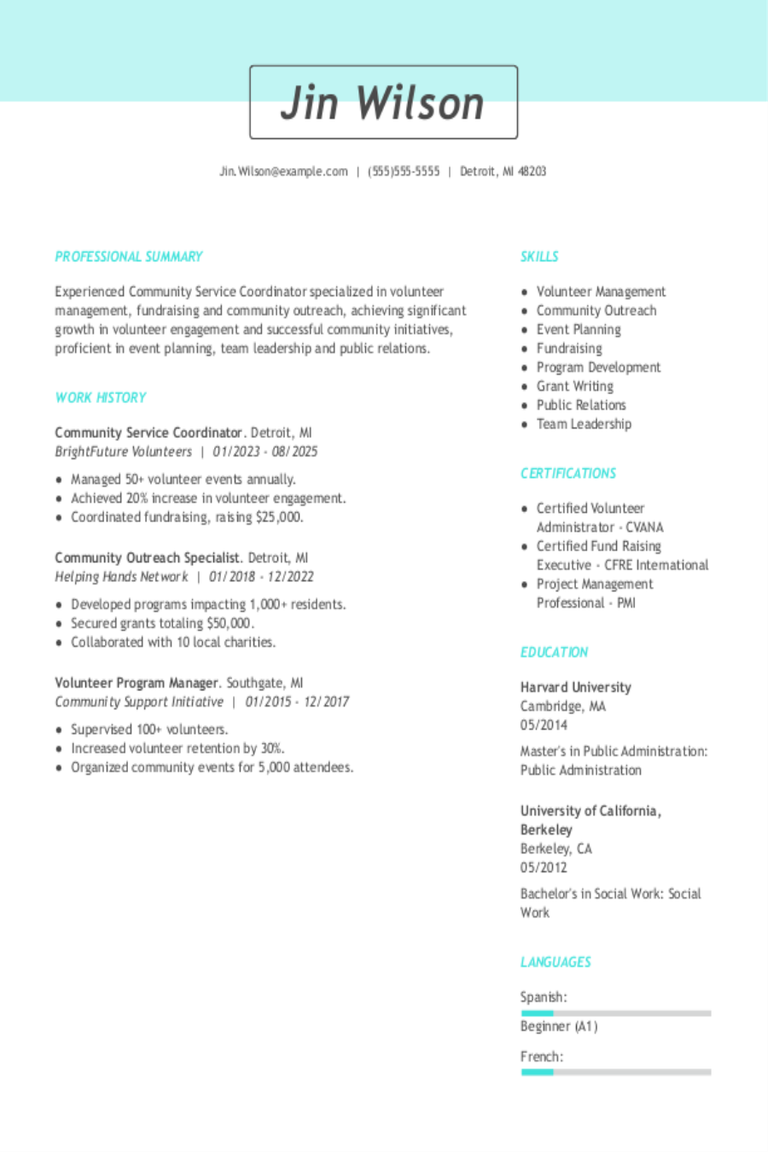
Community Service Coordinator Resume Examples & Templates for 2025
Explore community service coordinator resume examples and learn how to highlight your passion for helping others and your ability to organize successful projects.Build my resumeImport existing resumeCustomize this templateWhy this
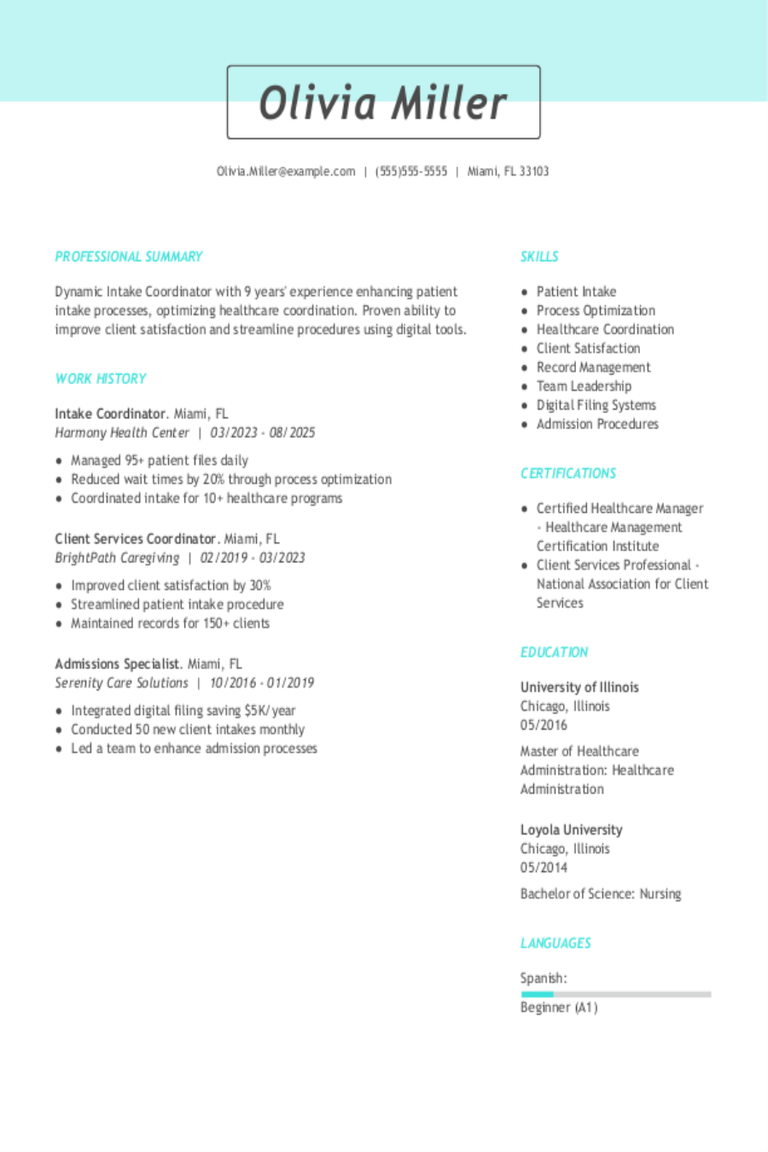
Intake Coordinator Resume Examples & Templates for 2025
Explore intake coordinator resume examples that focus on experience organizing patient information, managing schedules, and ensuring smooth communication. Learn how to highlight your ability to handle details and support healthcare
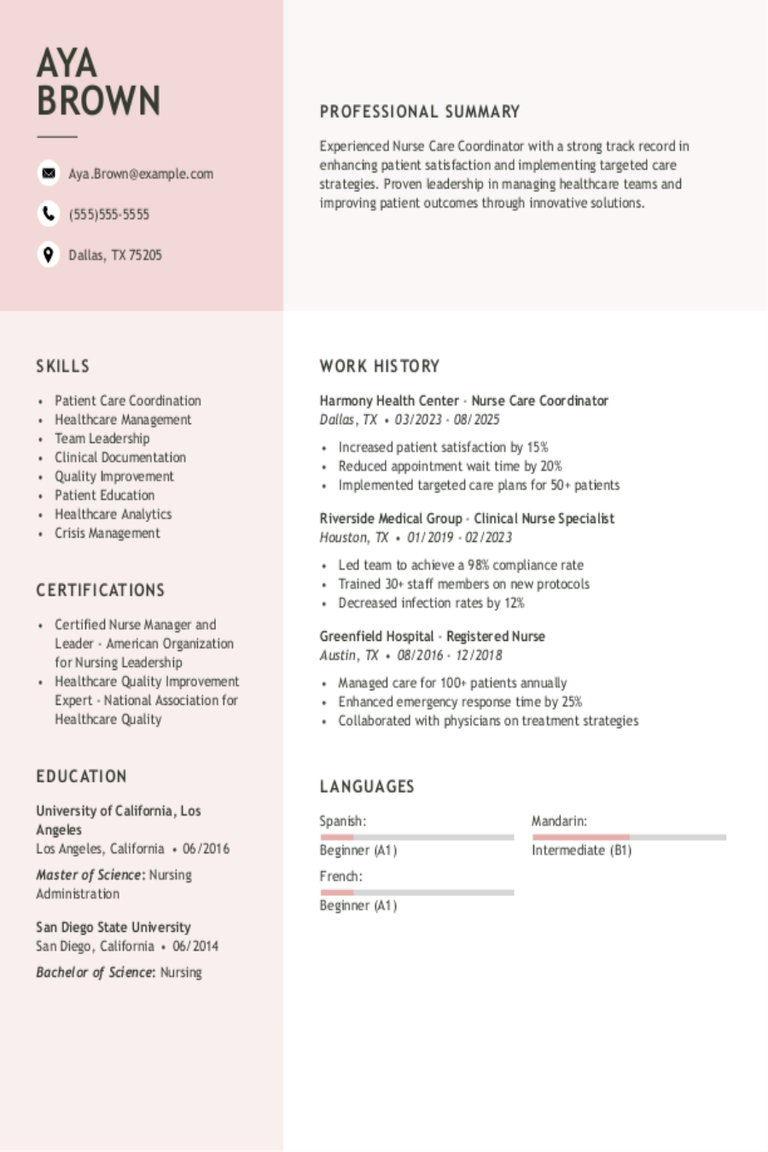
Nurse Care Coordinator Resume Examples & Templates for 2025
Discover how nurse care coordinators can showcase their skills in patient care and teamwork on a resume. Use our resume examples and tips to help you highlight your experience in
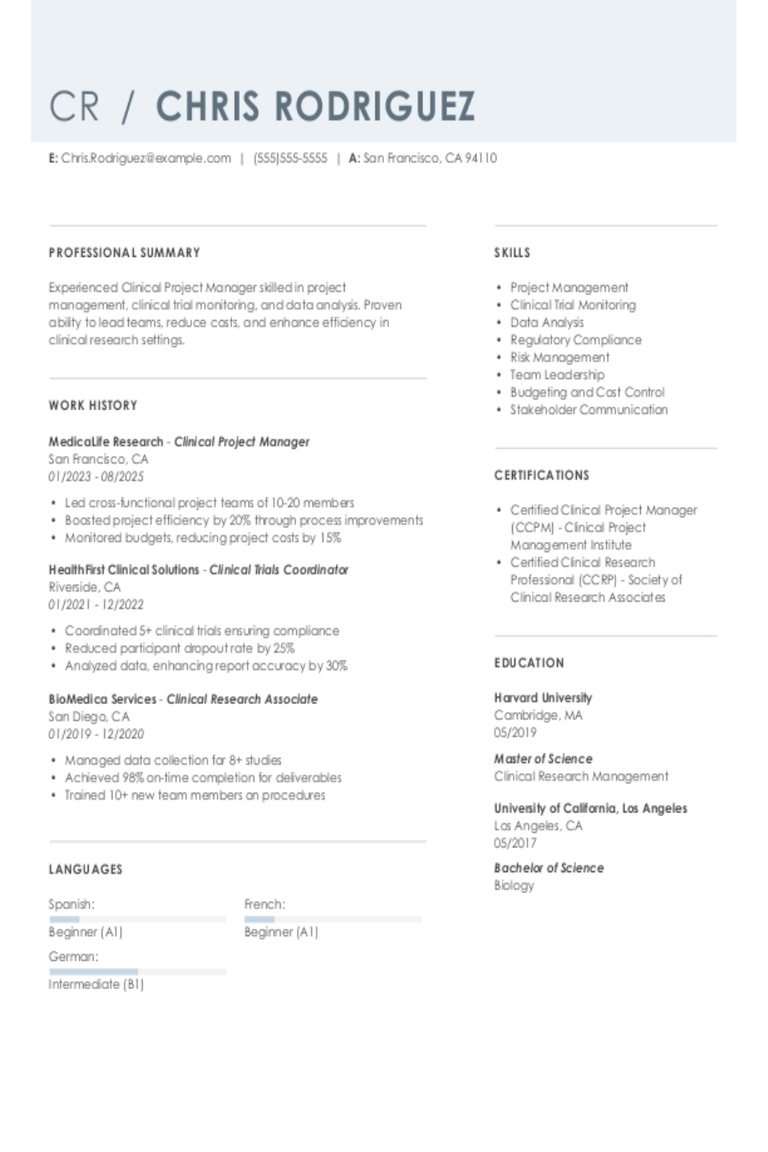
Clinical Project Manager Resume Examples & Templates for 2025
Explore clinical project manager resume examples to learn how to showcase your leadership in guiding medical studies and coordinating research teams. Get tips on emphasizing your ability to manage timelines,
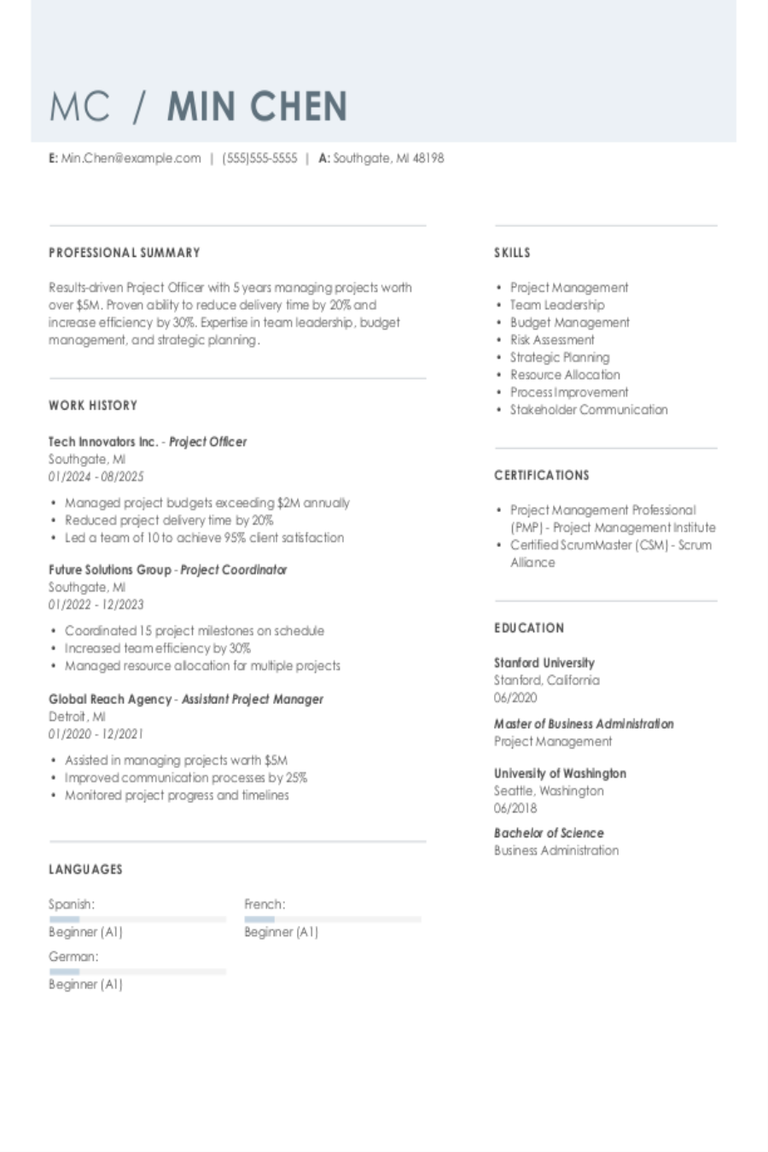
Project Officer Resume Examples & Templates for 2025
Explore project officer resume examples and tips to learn how to showcase how you manage timelines, coordinate teams, and handle budgets.Build my resumeImport existing resumeCustomize this templateWhy this resume worksQuantifies
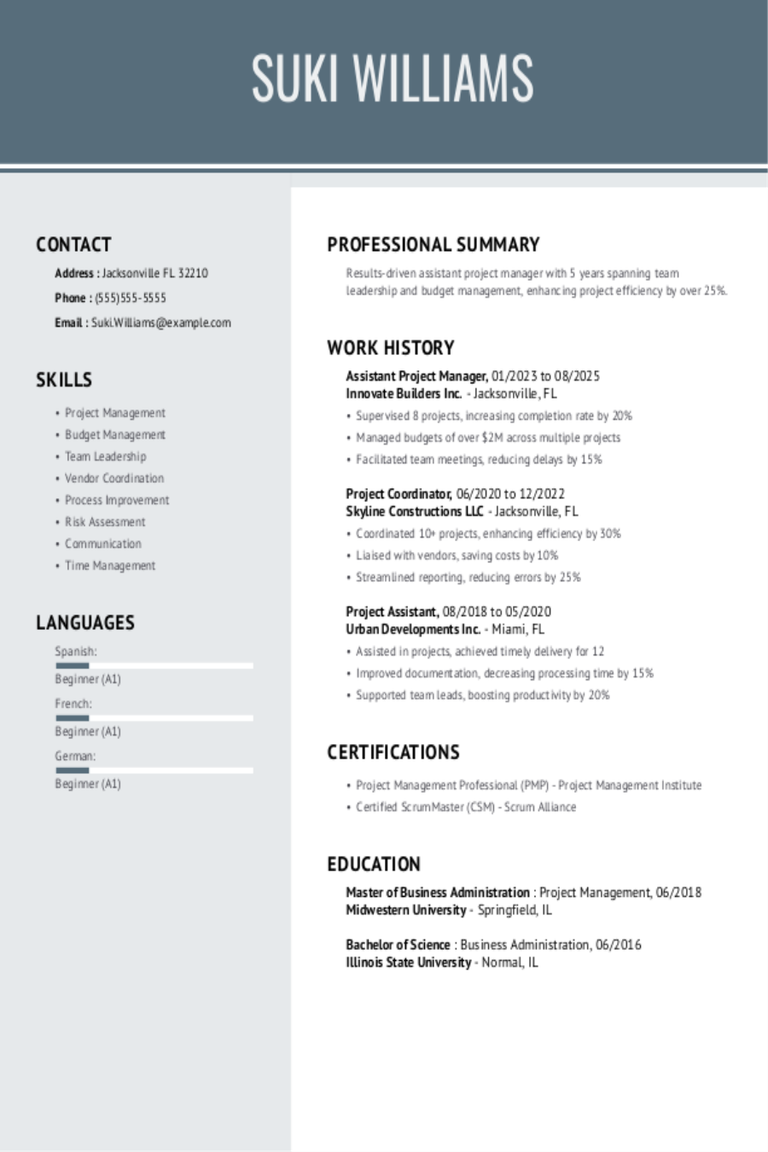
Assistant Project Manager Resume Examples & Templates for 2025
Discover assistant project manager resume examples and tips to help you craft a resume that highlights your planning skills and project experience.Build my resumeImport existing resumeCustomize this templateWhy this resume
